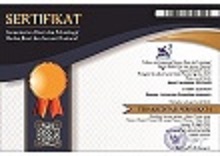KUALITAS SUBJEKTIF SEKOLAH RAMAH ANAK USIA DINI DI JAWA BARAT
Abstract
Abstract: School facilities and infrastructure, not only have to meet standards from a physical perspective, but also have to be early childhood friendly schools. This study aims to describe the architectural condition of early childhood schools in West Java based on the fulfillment of the school's physical standard requirements. This study uses a descriptive quantitative approach. Quantitative methods are used for the collection and analysis of quantitative data regarding the architectural condition of PAUD schools. Respondents, a total of 167 people who filled out a Google form questionnaire that was distributed online, were teachers, school principals, deputy principals, and school owners/heads of kindergarten/PAUD foundations. Based on the description of the research results, it can be concluded that in general the respondents' subjective perceptions of their schools indicate that most PAUD schools are architecturally child-friendly. On average, more than 70 percent of respondents, from the group of owners, principals/deputy principals, and teachers, as well as based on regional origin groups, said that their schools were in the category of friendly and very child-friendly.
Keywords: Child Friendly Schools, PAUD, Architectural..
Abstrak: Sarana dan prasarana sekolah, bukan saja harus memenuhi standar dari segi fisik, tapi juga harus menjadi sekolah ramah anak usia dini. Penelitian ini bertujuan untuk mendeskripsikan kondisi arsitektural sekolah anak usia dini di Jawa Barat berdasarkan pemenuhan persyaratan standar fisik sekolah. Penelitian ini menggunakan pendekatan kuantitatif deskriptif. Metoda kuantitatif digunakan untuk pengumpulan dan analisis data kuantitatif mengenai kondisi arsitektural sekolah PAUD. Responden sejumlah 167 orang mengisi angket google form yang disebar secara online adalah guru, kepala sekolah, wakil kepala sekolah, dan pemilik sekolah/ketua yayasan TK/PAUD. Berdasarkan deskripsi hasil penelitian dapat disimpulkan bahwa secara umum persepsi subjektif responden tentang sekolahnya, menunjukkan bahwa sebagian besar sekolah PAUD secara arsitektural termasuk ramah anak. Rata-rata responden, baik dari kelompok pemilik, kepala sekolah/wakil kepala sekolah, dan guru, maupun berdasarkan kelompok asal daerah, lebih dari 70 persen menyatakan sekolahnya berkategori ramah dan sangat ramah anak.
Kata Kunci: Sekolah Ramah Anak, PAUD, Arsitektural.Full Text:
PDFReferences
Achmadi, A. (2005). Ideologi Pendidikan Islam. Yogyakarta: Pustaka Pelajar.
Almaleki, D. A., Alhajaji, R. A. and Alharbi, M. A. (2021) Measuring Students’ Interaction in Distance Learning Through the Electronic Platform and its Impact on their Motivation to Learn During Covid-19 Crisis. International Journal of Computer Science and Information Security, 21(5), pp. 98–112.
Biswas, D., Ahmed, M., Roguski, K., and Ghosh, P. (2019) Effectiveness of a behavior change intervention with hand sanitizer use and respiratory hygiene in reducing laboratory-confirmed influenza among schoolchildren in Bangladesh: A cluster randomized controlled trial. The American Journal of Tropical Medicine and Hygiene,19(6), pp. 1–14, doi:10.4269/ajtmh.19-0376
Deputi Tumbuh Kembang Anak. (2015). Panduan Sekolah Ramah Anak. Kementerian Peberdayaan Perempuan dan Perlindungan Anak.
Diyanti Ayu Oktira. (2014). Lingkungan Ramah Anak pada Sekolah Taman Kanak-Kanak.. Jurnal RUAS, Volume 12 No 2, Desember 2014, ISSN 1693-3702 54 12, 54–68.
Eliterius Sennen. (2017). Problematika Kompetensi dan Profesionalisme Guru. Prosiding Seminar Nasional HDPGSDI Wilayah IV Tahun 2017, 16–21.
Hasanah, L., Hakim, W. L., Aminudin, A., Sahari, S. K. and Mulyanti, B. (2020) A Design and performance analysis of a telemetry system for remote monitoring of turbidity of water during the COVID-19 pandemic. Indonesian Journal of Science and Technology, 5(2), pp. 299–307.
Kementerian-PPPA. (2015). Panduan Sekolah Ramah Anak Deputi Tumbuh Kembang Anak. https://sekolahramahanak.files.wordpress.com/2013/11/juknis-final-3-2-16-1.pdf
Access Date, 22/02/2021.
Nurjaman, U., Sujiarto, H., Khoeriyah, N. D., & Khori, A. (2021). COMPETENCY-BASED TO INCREASE LIFE SKILL VOCATIONAL HIGH SCHOOL STUDENTS. Journal of Architectural Research and Education, 3(1), 44–50. https://doi.org/10.17509/jare.v3i1.33229
Permana, A. Y., Mardiana, R., Dewi, N. I. K., Sumanta, R. V. V., Ezzaty, F. M., & Nareswari, P. A. (2022). Evaluation of Classroom Performance in The Post-Covid- 19 New Normal Era at The Building Program Vocational High School. Journal of Southwest Jiaotong University, 15(2), 126–145.
Permana, A. Y., & Wijaya, K. (2017). Spatial change transformation of educational areas in Bandung. IOP Conference Series: Earth and Environmental Science, 99, 012029. https://doi.org/10.1088/1755-1315/99/1/012029
Porfeli, E. J., Hartung, P. J., & Vondracek, F. W. (2008). Children’s vocational development: A research rationale. Career Development Quarterly, 57(1), 25–37. https://doi.org/10.1002/j.2161-0045.2008.tb00163.x
Quirk, V. (2013). Forming Playscapes: What Schools Can Learn from Playgrounds. https://www.archdaily.com/214274/forming-playscapes-what-schools-can-learn-from-playgrounds. Access Date, 22/02/2021.
Razon, B. C. (2020) COVID 19: Impetus for ‘Community Spirits’ among Filipinos. Indonesian Journal of Science and Technology, 5(2), pp. 201–208.
Sagirani, T., Hariadi, B., Sunarto, M. J. D. Amelia, T., and Lemantara, J. (2021) Evaluation of User Experience on Using the "MoLearn"Application in Learning Activities of High School Students. International Journal on Advanced Science, Engineering and Information Technology, 11(6), pp. 2422– 2427
Susanti, I., Permana, A. Y., Pratiwi, W. D., & Widiastuti, I. (2020). Territorial space: Structural changes in a religious tourism area (The case of Kampung Mahmud in Bandung,West Java, Indonesia). IOP Conference Series: Earth and Environmental Science, 447(1). https://doi.org/10.1088/1755-1315/447/1/012031
Susanti, I. S., Komala Dewi, N. I., & Permana, A. Y. (2018). Tatanan Teritorial dalam Proses Transformasi Hunian. Jurnal Arsitektur ZONASI, 1(1), 27. https://doi.org/10.17509/jaz.v1i1.11542
Uray, I. (2015). Blingsatan Suatu Strategi dalam Peningkatan Kemampuan Guru Menulis PTK. Yogyakarta PT. Andi.
Vásquez, M., Roig-Vila, R., and Peñafiel, M. (2021) Teacher’s Digital Competencies. A Systematic Review in the Latin- American Context. International Journal on Advanced Science, Engineering and Information Technology, 11(6), pp. 2495- 2502
Washor, E. (2003). Innovative Pedagogy and School Facilities.
Watson, M. (2016). Career Exploration and Development in Childhood. In Career Exploration and Development in Childhood. https://doi.org/10.4324/9781315683362
DOI: https://doi.org/10.17509/jaz.v6i1.55940
Refbacks
- There are currently no refbacks.
Copyright (c) 2023 Indah Susanti Susanti

This work is licensed under a Creative Commons Attribution-ShareAlike 4.0 International License.





